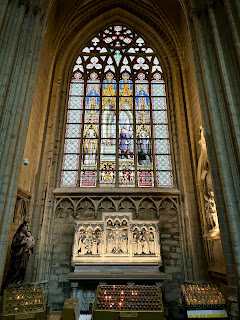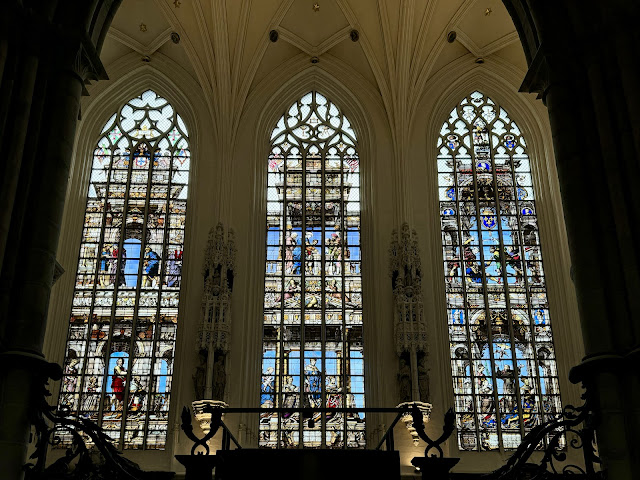The Bloementapijt (flower carpet) is done, installed on Thursday for the Maria-Tenhemelopneming - Assumption of Mary). The idea is to take our pictures during the morning quiet, but the crowd is already substantial. This early weather is not good, either – the clouds are muting the color of the flowers.
The Bloementapijt does not actually fill the Grote Markt (Grand Place), and it is not a symmetrical 'carpet' as previous images had shown. It's jazzy, Art-Deco. The featured design this year is by 'Whoups' (Océane Cornille), a street artist.
There are stoops at the front of the Huis van de Hertogen van Brabant (Dukes of Brabant, 17th century) at the southeast end of the Markt. They provide only a little vertical 'ift', but the pavement slopes down from here, so it's still not easy to frame the Bloementapijt.
It's better to just dive into the crowd and get those tight-angle shots – they're the only ones we're going to get. The Stadhuis van Brussel (City Hall, 15th century) and the Broodhuis (Bread/King's House, 16th century) provide the best backdrops – an incredible a sight.
The weather is not good, so while it's mostly dry, we head to the Kathedraal van Sint-Michiel en Sint-Goedele (Cathedral of St Michael and St Gudula, 11th to 15th centuries). We know the exterior from our walk to the museums on Wednesday. Today, we can dig into some of the details.
The Twelve Apostles stand around the central portal in groups of three, two to either side of the archway, and two above the door. On the column between the doors are the Three Magi. In small carved niches on the astragals of the doors are the patron and patroness of Brussels and this Kathedraal, Aartsengel Michaël (St Michael) and Sint-Goedele (St Gudula).
St Joachim and St Anne, the parents of the Virgin, are over the north tower door (to the left). While St Joseph and the Virgin Mary are above the south tower.
Unlike the other churches we've seen in Belgium, the facade is stone, but the screens over the lancets seems to expose the brick construction behind. It shares the chunky, vertical effect of the Brabantse Gotiek.
The entrance is at the south tower door.
The interior, however, follows the Brabantse Gotiek: round columns support pointed arch vaults, with bright, unadorned surfaces. In the clerestory, the windows are clear, patterned glass, except in the apse. But the aisles are adorned with stained glass, in this case large and richly colored (Jean-Baptiste Capronnier, 19th century) The aisle windows depict the so called 'Sacrament van Mirakel' (aka, the "Brussels Massacre") in which a group of Jewish thieves desecrate the Eucharist on Good Friday, 1370) only to have the wafers miraculously 'bleed'; the thieves are later executed.
We begin in the north aisle. In the first window, Jewish prisoners are brought before a magistrate; the dedication to St James the Minor and St Louis, King of France (with a history of anti-semitism). Next, a group of priests robed in white transfer the 'miraculeuze hosties' under a canopy with the King and Queen. In the old church of St Gudula, a weaver is struck by heavenly light (identified in the catalog as Jean le Tisserand) and told by Christ to revive the procession. Mary of Hungary follows the procession of Margaret of Austria (restarted in 1529).
We step into the nave to re-orient and look up to find a statue of St Bartholomew (17th century) with his skin and flaying knife. Just ahead are the other Apostles and the new pipe organ (installed in 2000).
At the crossing, we turn and look back at the large west window (over the central portal, top image and below). This is The Last Judgement window (Jean Haeck, glassmaker & Bernard van Orley, designer, 1528), with St Michael (with scales of justice) and the Seven Trumpeters in the blue band at the center. Above, Christ (red robe, on blue arc) judges the righteous (to HIs right) and the damned (to His left), surrounded by the Apostles. The Virgin appears at the far left, and St John the Baptist (pointing) is at the far right. Below, in a rush of naked bodies and a burning landscape, the donor, Everhard van der Marck, calmly watches.
In the north transept is another larger, old window (Haeck & van Orley,1537); Charles V and Isabella of Portugal kneel before God the Father with the monstrance containing the 'miraculeuze hosties'. As we enter the ambulatory, we are greeted by a stern St Michael (M de Martelaere, 1912). The north side of the ambulatory is the De kapel van het Heilig Sacrament van Mirakel. The three lateral tall glass panels begin the legend of the 'Sacrament van Mirakel' – the Kathedraal's art committee is going all-in on the Mirakel story.
In the first window, our eyes are immediately drawn to the crest and flag of Portugal, and the ornate architectural framework that creates the two registers of each frame. In the upper register, Two Jews conspire and exchange money for the hosties, and below is the dedication to John III of Portugal and Catherine of Austria with their patron and patroness saints. In the central panel, a group shares the hosties (dedication: Louis II and Mary of Hungary), and in the far window, the group is massacred (dedication: Francis I and Eleanor of Austria).
In the corner, the family of the thief secrets the hosties to Brussels, and in the east window is the 'Triumph of the Blessed Sacrement' (Capronnier, 1848) – Charles V and Isabella of Portugal, and their children and saints, pay homage to the recovered hosties.
The Maeskapel (17th century) is a small, hexagonal domed structure directly in back of the altar. This contains the Renaissance altar Passie-retabel (Jan Mone, 1538).
There is more Capronnier stained glass (1843): St Michael on the left, the Holy Trinity at the center above the retable, and St Gudula on the right. We see St Michael, of course, with his spear and the dragon (Satan), and St Gudula with her book and lantern; a demon is always trying to snuff out her light.
The kapel van Onze-Lieve-Vrouw (Our Lady) is on the south side of the ambulatory with more colossal, aged stained glass illustrating the Marian Cycle (Jean de Labarre, glassmaker & Theodoor van Thulden, designer, 1654-63). In the corner window, is 'The Presentation of Mary in the Temple' (1656, dedication: Emperor Ferdinand III of Austria and Eleanor of Austria), and at the side is the 'Marriage of Mary and Joseph' is (1658, dedication: Emperor Leopold I).
'The Annunciation' is next (1663, dedication: Archduke Albert and Duchess Isabella), and then 'The Visitation' completes the Cycle (1654, dedication: Archduke Leopold Wilhelm). Finally, the painting in the chapel altar is the Maria-Tenhemelopneming (Jean-Baptiste de Champaigne, 17th century), as she departs Earth for Heaven.
In the glass over the main altar, The Virgin and Child are at the center, with St Michael on Her right and St Gudula on Her left (Nicholas Rombouts [?], 1520-30).
In the south aisle, the story of the 'Sacrament van Mirakel' continues (Capronnier & Charles de Groux, 1856-70). The conspirators make their final plans and descend the ladder with the ciborium. Next, a group of Jews laugh at the hosties spread on the table, while the thief leaves with his money; he is killed in the following scene.
In the center window, the Jews desecrate the hosties, cutting them with their knives only to see them 'bleed'; the patron and patroness of this panel are St Michael and St Gudula. In the last screen, the penitent Catherine, a recent convert to Christianity, returns the hosties to Duke Wenceslas and Duchess Jeanne of Brabant.
Given modern sensibilities, this story is very uncomfortable. But what to do with all this truly amazing art? This is not quite 'Confederate statues' level offensive as we must dig deep to grasp the story, Rodin did not carve them, and we are in a cathedral not a synagogue – but it is conflicting and difficult.
Before leaving for lunch, we stop to look at the pulpit; it seems like all the big churches in Belgium have these crazy Rococo pulpits (Hendrik-Frans Verbruggen, 18th century). From the back, this looks like a dark forrest but with large birds and angels, reminiscent of the Expulsion from Paradise to the pulpit we saw in Ghent. In front, we see Adam and Eve and the angel is driving them, along with a skeletal Death, out of Eden.
Two more angels are holding the canopy, and on the canopy, the Virgin and the child Jesus are destroying the serpent with the Cross. Thus, we have Original Sin and Redemption.
Despite the disturbing narrative, the Kathedraal and its stained glass are better than expected and a real visual treat.
We recall the carpet is part of the Maria-Tenhemelopneming, Assumption of the Virgin. Though the timing is coordinated, there does not appear to be a religious aspect to the artwork; there may be a sense of 'lifting' or a connection made between Earth and the Heavens.
Putting aside the troubling legend, the stained glass in the Kathedraal works in the same way. In this context, it's about a country and a city that loves colors, flowers, and the arts, and celebrates them.
De Joodse gemeenschap van Brussel werd in 1370 beschuldigd en gestraft voor de profanatie van het H. Sacrament. Op Goede Vrijdag 1370 zou men in de synagoge gestolen hosties met een dolk doorboord hebben. Uit de hosties zou bloed gevloeid zijn. De diocesane autoriteiten van het bisdom Mechelen-Brussel hebben in de geest van het Tweede Vaticaans Concilie en na kennisname van het historisch onderzoek, in 1968 de aandacht gevestigd op het tendentieuze karakter van de beschuldiging en de legendarische voorstelling van het 'mirakel'.[In 1370, the Jewish community of Brussels was accused of the profanation of the Holy Sacrament and punished for this act. It was claimed that on Good Friday, 1370, Jews used daggers to stab communion wafers which had been stolen from a chapel. Blood was said to have flowed from these wafers. In 1968 in the spirit of the Second Vatican Council, the authorities of the archdiocese of Mechelen-Brussels, in the light of historical research on this subject, drew attention to the tendentious character of these accusations and to the legendary nature of the ‘miracle’.]Commemorative plaque in the Treasury of the cathedral, formerly the chapel of the Blessed Sacrament, inaugurated in 1977 by the Cardinal L.-J.Suenens (translation)


































































